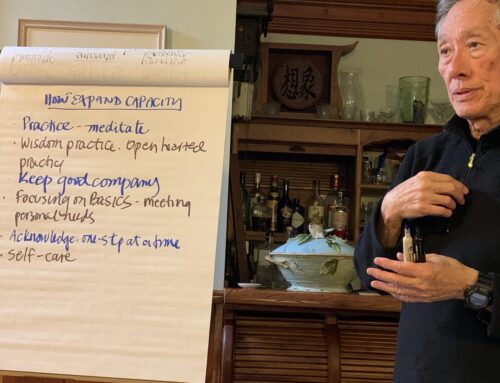
Image by brenkee
According to Promises Treatment Center, “Being emotionally sober means getting in touch with your emotions, whether positive or negative, and allowing yourself to feel them.” This, of course, is a key component of the practice of mindfulness.
As one of our teachers at InStill, Anna Pittman, likes to say, in practicing mindfulness we are not so much trying to let things go as we are trying to let them in. When we come across a difficult emotion, instead of trying to push (or wash, or pop, or smoke) it away, we welcome it in, investigate it, experience it, and give it the compassion it is longing for.
In A Course in Miracles, it says everything is either a cry for love or an expression of love. A difficult emotion is—in this context—a cry for love. In our culture we have typically been taught to deny these emotions, which simply leaves them bottled up inside. As we continue to bottle them up, they build and build until we find a way of releasing them. Drugs and alcohol appear to be great mechanisms for this, partly because they help distract us from our current reality, but also because they enable us to shift the responsibility for our words and actions from ourselves to the substance we are abusing.
If, instead, we embrace these emotions as non-judgmentally as possible, and simply notice the experience of having them, we put ourselves in a position of understanding in which we can see both where the emotion is coming from, and the impact it has on ourselves and others.
This doesn’t mean that we stop having these emotions, especially not in the short term. Indeed, as we begin to uncover some of the more difficult emotions that we’ve been trying to hide from ourselves and others, we may even experience them more often and more intensely. What it does mean is that we come to accept them as a part of who we are in this moment.
Which leads to another core concept of mindfulness: impermanence. One thing that helps drive some of our strongest emotions is identifying with them: how many times do we hear someone say something like, “I’m an angry person,” or “I’m always depressed”? There is a solidity that comes with identity, that makes it so much harder to shake off. The truth is that we are not any one of our emotions, instead we are a constantly changing conglomeration of emotions, thoughts, sensations, perceptions, and experience. With mindfulness, we come to appreciate this and become more attentive to what this is now. As Ajahn Sumedho likes to say, “Right now, it’s like this.”
When we appreciate the impermanence of an emotion, we loosen our attachment to it, and therefore our identity with it. As this happens, it becomes much easier to come to terms with it, because we are no longer looking at “me”, but “a part of me in this moment.”
So emotional sobriety is a byproduct of practicing mindfulness. This is an important point. Another key concept of mindfulness is detachment, and this includes detachment to expectation. If we practice mindfulness with the intention of developing emotional sobriety, we are much less likely to achieve it that if we practice mindfulness simply to see what happens next (or, more appropriately, to see what is happening now). Certainly, intention is important in mindfulness, but only insofar as your intention is to practice mindfulness to the best of your ability. Beyond that, intention becomes expectation, and expectation is blinkered, blinding us to the full range of possibilities that lie before us.
The only question really is, where do you start? And the answer is simple: start here, with this. Wherever here may be, and with whatever this is now. If it happens to be a difficult emotion, fantastic! If it happens to be a wonderful emotion, fantastic! If it happens to be a recurring thought, fantastic! It really doesn’t matter: just be with it and notice with curiosity what you have before you. That is all mindfulness really is.




Terrific post thanks Jamie and a great reminder. The bit that especially struck home for me was about seeing feelings as a cry for love and embracing them. Embracing is such an evocative word, much more than simply noticing…